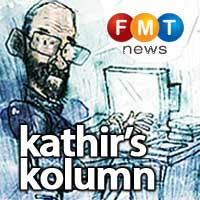No tear gas was fired, no one was arrested and there was no violence in the three protests held recently – welcome to the new Malaysia.
COMMENT
 By A Kathirasen
By A Kathirasen
There have been at least three street protests in the past ten days. All of them were peaceful. The protesters came, they shouted, they left.
Police did not use force, or did not need to use force, to break up any of the three gatherings.
On July 20, about 300 Muslims protested after Friday prayers at the Masjid Jamek Shaik Eusoff in Jalan Macalister, Penang, against Penang Deputy Chief Minister II P Ramasamy’s call for controversial preacher Zakir Naik of India to be sent back if India were to request for Naik’s extradition.
They also claimed that Ramasamy had links with the now defunct Liberation Tigers of Tamil Eelam (LTTE), which has been listed as a terrorist organisation by about 30 countries, including Malaysia. The LTTE was defeated in 2009 by the Sri Lankan government with the aid of several nations. Ramasamy says he was helping the peace process.
A week later, on July 27, two opposing groups – one supporting Ramasamy and the other against – gathered at Komtar in Penang. The supporters were non-Muslim Indians. Those against were Muslims.
It was a potentially dangerous mix. Religion and race were at play. However, there was no violence, as the protesters dispersed peacefully after engaging in a shouting match.
On July 28, almost 2,000 Malays gathered at Kampung Baru in Kuala Lumpur to protest what they perceived as a threat against Malay and Muslim interests in the nation because of the Pakatan Harapan (PH) government’s policies.
The speakers claimed that Islam and Malay rights were in danger. Many in the crowd were unhappy with the appointments of non-Muslims to three top positions recently: Tommy Thomas as attorney-general, Richard Malanjum as chief justice and Liew Vui Keong as minister in the Prime Minister’s Department in charge of law.
The crowd later dispersed peacefully.
As usual, at all three gatherings, policemen – both uniformed and in plainclothes – were in attendance.
Deputy Inspector-General of Police Noor Rashid Ibrahim expressed happiness at the way the Kampung Baru protest went. He said: “We tried to ease the organiser’s business and co-operate with them. This is the kind of gathering we want and hope to see in the future. We will help any such gathering and we hope that organisers will follow the rules and regulations that have been set.”
I am happy with this new attitude of the police. It augers well for democracy. I am also satisfied with the way the crowds at all three protests handled themselves. It augers well for democracy, too.
Compare this with protests and gatherings before the May 9 general election. The authorities threw all sorts of obstacles in the way of protest organisers. And organisers of protests in the past had almost always complained that police were not helpful.
Most readers would recall the many incidents where police fired tear gas and water cannons, used batons, or arrested protesters.
The Malaysian Human Rights Commission, or Suhakam, lawyers groups and NGOs have over the years spoken up against attempts to frustrate citizens’ right to protest. In fact, after the Bersih 5 rally for free and fair elections and the Red Shirts rally to oppose Bersih in November 2016, Suhakam reminded the police that any attempt to prevent peaceful assemblies was unconstitutional.
At least 14 people were arrested, including Bersih chairman Maria Chin Abdullah and Red Shirts leader Jamal Md Yunos, in the opposing rallies in Kuala Lumpur.
A year earlier, a day before a Berish 4 rally, then home minister Ahmad Zahid Hamidi banned all items related to the rally. This included the ridiculous ban on the wearing of yellow-coloured t-shirts with Bersih 4 on it in any part of the country. Such materials, the authorities stated, were “likely to be prejudicial to security” and to “national interest”.
Remember, 29 people were arrested on May 1, 2015, during an anti-goods and services tax protest in Kuala Lumpur?
Remember, 589 people were arrested after tear gas was fired and water cannons used to break up a rally protesting the Internal Security Act in Kuala Lumpur in August 2009?
Remember, 1,401 people were arrested in July 2011 after police fired tear gas to break up a protest against the government of Najib Razak?
Earlier, in November 2007, police fired tear gas and water cannons, and arrested more than 130 people when protesters led by Hindraf tried to hand over a memorandum on the treatment of Indians to the British High Commission in Kuala Lumpur in November 2007?
All that happened during the rule of the Barisan Nasional.
So, those who participated in the recent protests should be happy that the PH government is different, that it is allowing people the freedom to gather and protest – a fundamental right of all citizens.
They, and we, should be happy that the police are adopting a new, and better, approach in line with the democratic policy of the new government. The job of the police is not to place impediments or break-up peaceful protests; rather, they should facilitate demonstrations so that there is the least disruption in the normal cycle of everyday life. However, they should be alert and act against any troublemaker.
So, there is greater space for freedom today under the PH government. It is incumbent upon those who wish to protest to ensure they do so peacefully. Both protesters and the police should work together to ensure that citizens get to exercise their rights, but without causing chaos.
It is very important that people do not abuse the space, the freedom that is now available. Any abuse will only provide an excuse, or reason, to the authorities to place restrictions on freedoms. -FMT
No comments:
Post a Comment
Note: Only a member of this blog may post a comment.